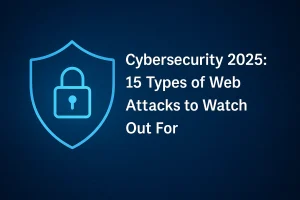 The internet often feels like an outlandish digital frontier: a thrilling and dynamic place offering innumerable opportunities. But just like the earlier Wild West, it is one riddled with risks and dangers. There exists a whole world of shady people, also known as "threat actors," who use web attacks to break into websites, steal sensitive data, and spread all kinds of chaos.
The internet often feels like an outlandish digital frontier: a thrilling and dynamic place offering innumerable opportunities. But just like the earlier Wild West, it is one riddled with risks and dangers. There exists a whole world of shady people, also known as "threat actors," who use web attacks to break into websites, steal sensitive data, and spread all kinds of chaos.
You might be wondering, "What can I do to protect myself?" The answer is knowledge. The very first step for you to build a strong defense for your online presence is to comprehend the various types of web attacks. This is where 4GoodHosting comes in. As a leading secure Web Hosting Provider in Canada, we work to protect your website and let you focus on your business, be it an utterly traditional enterprise or a totally odd yet successful business idea you nurtured into being.
Let's delve into the details tackling 15 most-known web attacks. For each attack, we will take you through a simple definition of what it is, a simplified process of how it works, with steps that are crystal clear, about what you can do to protect yourself. This is with the professional touch of your partners 4GoodHosting.
SQL Injection (SQLi): The Database Interrogator
A SQL Injection attack is thus a burglar that works in a more sophisticated way by deceiving the security of the vault into opening its doors for them, rather than simply attempting to rob it. Think of your website's database as the brain of your operation—an organized vault painstakingly collecting customer details, inventory lists, and so on.
How It Works: A Deceptive Command
An attacker will find loopholes in the application code against which the integrity was not properly controlled. They would enter a user name plus a specific string of SQL commands into the login field. For example, a normal query to check a username would look like:
SELECT * FROM users WHERE username = 'user_input';
The attacker could type in 'admin' —" The transformation of the query looks harmless:
SELECT * FROM users WHERE username = 'admin' --';
Here, double dash (--) is a comment in SQL, so the rest of the original query is ignored. The database sees admin as a username and gives access to the intruder, who at this stage is not required to provide any password. This is a very simple example, but attackers can issue more complex commands to extract, modify, or delete an entire database-an operation that can lead to the stealing of millions of records containing personal identifiable information (PII) and financial information.
The Real Danger: Compromised Integrity
If successful, SQLi can cause:
- massive data breaches from the destruction of certain types of sensitive information like credit card numbers, passwords, and personal information.
- In very serious cases, attackers get administrative control of the database server, permitting them to install malware or pivot to other systems on the network.
- Fining, legal action, and an utter destruction of customer trust leading to astronomical losses with financial and reputational consequences.
What 4GoodHosting Does: Strengthening the Walls
At 4GoodHosting, we have multiple protective measures against SQLi:
- Web application firewalls (WAF): Our hosting environment has WAFs that protect your web application. A WAF analyzes incoming traffic and filters malicious SQLi patterns before they even reach your website code.
- Secure environment configuration: We enforce secure server configurations based on the least privilege, ensuring the database or web application has only the permissions they need to operate.
- Active monitoring and updates: We constantly look for fresh threats and vulnerabilities and apply security patches and updates to our infrastructure to counter any action by the attackers. While we do provide the security capabilities, we still highly encourage developers to use "best" practices, such as prepared statements and parameterized queries, that clearly separate user input from the SQL code itself to thereby completely lock this type of attack out.
Cross-Site Scripting (XSS): The Trust Exploiter
Think of your website like a trustful newspaper shop. You have brought together good content, but XSS becomes a bad joke, as it is like a swindler sneaking an artificial malicious article in for exhibit. The attacker is not trying to break into your stand; rather, they are trying to dupe your customers into reading negative info, swap wallets, or pass through a bad alley. This particular attack does not directly impact your server, but rather takes advantage of your customers' reliance on the security of your website to drop harmful code into their browser.
How It Works: The Malicious Payload
The XSS attack, if successful involves injection of some sort of client-side script (usually Javascript) by the attacker into the webpage. This could be done if a page had any input field that was not properly validated; comment sections, search boxes, or user profiles could be possible entry points for injectable scripts. Serviceably, a classic example of such a script would be if an attacker were to post a comment as one that reads - this: This is a great article! <script>window.location='http://malicious-site.com'</script>
If such a website's code is dumb enough just to echo this comment, the browsers would interpret and run the whole <script> tag, leading to them being redirected immediately to the attacker's site-a redirect attack in its own right. Every script could be abused to:
- Steal Cookies: This is the seizure of the session cookies, which grants an attacker to impersonate the user without the need for the password.
- Log Keystrokes: Track silently and record every single key stroke the user makes on the site, leading to the theft of their encrypted credentials and other personal information, like debit card numbers.
- Deface Websites: This changes the site appearance and compromises the reputation.
The Real Danger: A breach of trust on the part of the user
It is clear that the consequences of XSS attacks go a long way and down very far. Consequences may:
- Breach User Accounts: Once the session cookie equally gets to the attacker, the user's account is there to be assumed by the attacker to perform the unknown.
- Spread Malware: This is accomplish ed by using the injected script to command the browser to download and install the malware.
- Deteriorate Trust: Users that have been victims to your site's assault will lose confidence in it from a security point of view, leading to a partial and dangerous devaluation of the good name and clients.
How 4GoodHosting Can Help: A Multi-Layered Approach
4GoodHosting provides many synergized defenses to stave off the assaults of XSS:
- Security Headers: We put in place critical security headers that can regulate the behavior of modern browsers, by implementing Content Security Policy (CSP) or X-XSS-Protection. A CSP could, for instance, be configured not to allow any scripts that come from dubious sources to be run in a site, holding back malicious injections from running.
- Regular Security Updates: We constantly check to update the base server-software and platforms, always securing up and closing any known vulnerabilities that could be exploited towards XSS.
- Developer Best Practices: To date, we educate and uphold the strong base of infrastructure for developers. Security best practices recommend simulated encoding of input, including its validation, while ensuring that any user input involved is logged, filtered, and sanitized such that the script tag and special characters are dealt with before the same are shown on any browser. Our effort therein educates and supports our customers toward such important cornerstones of security.
Cross-Site Request Forgery (CSRF): The Unwanted Favor
CSRF is like someone tricking you into performing a deed you never intended. What that means in the web world is an attacker could trick a logged-in user into performing unknowing requests against a web application.
How this works is that the attacker might send a harmless looking email or link containing malicious code. If the user is logged into an application vulnerable to such an attack and opens either the link or the email, then the browser sends an unauthorized request to the application on behalf of that attacker. It may result in unauthorized money transfers, change of passwords, or any unwanted acts.
Why should it be dangerous? Due to financial damages incurred due to CSRF attacks, unauthorized modifications in data occur and are also performed without victim concern.
How 4GoodHosting has helped: The primary aspect of CSRF protection is secure coding mechanisms into the web application (for instance, applying anti-CSRF tokens). Still, the hosting environment is indeed secure to run safe applications. The safe development practices are shared and supplemented with resources.
Denial of Service (DoS) and Distributed Denial of Service (DDoS): The Traffic Jam
Picture a very crowded highway that suddenly blocks due to being backed up by a large pile-up. This is how a server is brought down by a DoS or DDoS attack. The aim of this is to bombard that server with possible connections from compromised resources to make the server unreachable from all its potential legitimate users.
How it works:
- DoS: One-with an army of requests to one-single server will actually occupy the resources (bandwidth, CPU, memory) so that it won't be able to serve anymore.
- DDoS: This is actually a much more potent attack. It does not flood the traffic; rather it uses a compromised network of computers, referred to as the botnet. From the many areas, it attacks the target server at the same time, making it almost impossible to block the attack source.
Why it's dangerous: DoS/DDoS attacks can lead to site downtime, loss of business, and personally affect reputations.
How 4GoodHosting helps: We have excellent infrastructure and DDoS mitigation mechanisms to detect and filter out malicious traffic. This ensures that your website remains accessible even during an attack, as links can sustain very high traffic spikes.
Man-in-the-Middle (MITM) Attack: The Eavesdropper
An MITM attack is like a guy lurking in that modality between two people they share a private space with: in the middle, probably even manipulating what they say. In cyberspace, it means an attacker breaking into the communication between the user and web server.
What this means is that an attacker positions themselves in between the web server and the user's browser and ostensibly receives the data being exchanged. They can even eavesdrop on such sensitive details as login credentials, credit card details, or personal data. In some instances, they even manage to manipulate the entire process without either participant becoming aware.
Why it's dangerous: This can lead to identity theft, financial fraud, and compromise of sensitive information.
How 4GoodHosting helps: We have always implemented HTTPS (Hypertext Transfer Protocol Secure) for all our hosted sites with strong SSL/TLS certificates. Thus, the communication channel between the user's browser to the server is strongly encrypted. Therefore, it becomes extraordinarily tough for attackers to eavesdrop or tamper with data.
Phishing: The Digital Deception
Phishing is a type of social engineering applied in the attempt to con somebody into presenting confidential information in an impersonating legitimate entities. It's like a fake email your bank sends, asking why you have not given the bank your log in details.
How it Works: The attackers will send these fake emails, texts, or create completely fake websites that look really genuine. They can base their fraudulent theft on the theme of being a bank, social media, or any affiliation with a government agency. Then they will lure people so that victims can provide information about that derailed format, like username, password, credit card number, or even social security number.
Why it's Dangerous: Phishing attacks cost consumers lost funds and, by extension, identity theft, and account compromise.
How 4GoodHosting Helps: We do not control phishing emails you might receive, but our secure email hosting service comes with spam filtering and anti-phishing measures that help cut the number of email-based threats reaching your inbox. We also teach our clients how to identify scams and ways to avoid being victimized by scammers.
A Persistency-Guesser Brute-Force Attack
Just imagine a person trying to break into a locked door by trying all possible keys. A brute-force attack largely works like this. Attackers keep on trying usernames and passwords with the all-time purpose of entering an unauthorized account.
How it works: Hackers use automated tools to systematize the guessing combinations of usernames and passwords until a successful match is made. This can be against login forms, API endpoints, or any other authentication mechanisms.
Why it's Dangerous: Successful brute force attacks can result in account take-overs, data breaches, and unauthorized actions.
How 4GoodHosting helps: We have installed defenses such as rate limiting and lockout policies against brute-force attacks on our servers for hosting accounts. We also strongly encourage users to make strong, unique passwords and activate multi-factor authentication (MFA) where possible.
Password Cracking: The Code Breaker
Cracking of passwords is more technique bound, whereas brute force attacks try every combination. During the cracking process, a password is recovered from its hashed form. Hashing usually converts any password to an unreadable string of characters. With the right tools and techniques, these can be sometimes reversed by attackers.
How it works : Attackers may attempt to crack the password hashes using dictionary attacks (anything common to use as words or phrases), rainbow tables (which are basically pre-computed password hashes), or some sophisticated cracking software.
Why it's dangerous - Successful password cracking can easily lead to unauthorized access to accounts containing sensitive data or information.
How 4GoodHosting helps - Strong hashing algorithms are used by us to store passwords on our servers, and we encourage users to follow the best practices in creating strong and unique passwords that are more resistant to cracking attempts.
File Inclusion Vulnerabilities: The Uninvited Guest
Imagine your website allowing external inclusion by anyone. Such allowance could grant attackers an entry lever for uploading and running malicious scripts on the server. This explains the nature of file inclusion vulnerabilities.
How it works: File inclusion vulnerabilities occur when a web application allows user-controlled input to be used in file paths. Attackers can exploit this by injecting paths to malicious files (either local files on the server or remote files on an attacker-controlled server) that the web application will execute.
Dangerous: By including files, remote code execution can be done, granting control to the attacker over the web server, making away with data, or defacing the website.
How 4GoodHosting helps: We have a secure hosting environment configured with restrictions against file access and unauthorized file inclusions. We also encourage developers to implement proper input validation and sanitization to avoid these vulnerabilities in their code.
Command Injection: The Server Controller
One severe vulnerability that has immense consequences is command injection, where an attacker finds a loophole allowing him to run commands directly on your web server.
How it's done: These vulnerabilities occur when a web application passes user-supplied input directly to the operating system shell for execution without proper sanitization. Attackers th en proceed to inject malicious commands that the server executes, which may include creating, deleting, or modifying files, installation of malware and even full control of the server.
Why it's dangerous: Command injection can lead to complete server compromise, data breaches, and website defacement.
How 4GoodHosting helps: Our server configurations are hardened to protect against command injection to the maximum possible extent. We further advise developers not to pass unsanitized user input directly to system commands, using secure alternatives whenever possible.
Session Hijacking: The Imposter
Think of session hijacking as someone stealing your house keys during your absence and pretending to be you. An attacker steals a user's session ID, impersonating that user and gaining illegal access to their account.
How it works: Once a user logs into a web application, the generation of the session ID identifies that user for subsequent requests. The attacker can obtain the session ID in multiple ways—ranging from XSS to MITM attacks, or even guessing weak session IDs. Having gained access to the session ID, the attacker uses it to structure web application requests as if they were the real user.
Why it's dangerous: Account takeover, unauthorized transaction, and access to sensitive personal information.
How 4GoodHosting helps: We enforce the use of secure session management practices on our servers, including the use of secure cookies and mechanisms to prevent session fixation. We also encourage developers to implement proper session invalidation upon logout and to use sufficiently random and unpredictable session IDs.
Cookie Theft: The Digital Crumb Snatcher
Cookies are small bits of information recorded on a user's computer by a particular website to remember details about that user, such as login status or preferences. Cookie stealing means that an attacker steals the cookie information to have access to that particular user's account without consent.
How it works: Cookies can be stolen by the use of XSS attacks, malware, or sniffing networks (in cases of unencrypted connections). A session cookie, once obtained, can often be used by attackers to evade the login processes and gain access to the user's account without knowing his username or password.
Why it is dangerous: Cookies are usually used in account takeover, where an attacker can access the information without any consent.
How 4GoodHosting helps: To help make sure cookies are not intercepted, we enforce HTTPS and use secure cookie settings at our servers. We also encourage users to keep their browsers an d operating systems updated to prevent infections from malware that would then be used to carry out cookie theft.
Directory Traversal: The Forbidden Path
Imagine an attacker finding a way to navigate through your website's file system and access files they shouldn't be able to. That's the essence of directory traversal vulnerability.
How it works: These vulnerabilities occur when a web application allows user input for file paths without appropriate validation. Then, the attackers manipulate the input, introducing special characters (like "/../") that help them navigate back through the directory structure and access sensitive files lying outside the supposed webroot.
Why it's dangerous: Attackers may exploit directory traversal vulnerabilities to get access to configuration files, source code, or other sensitive information, which could lead to other attacks or data breaches.
How 4GoodHosting helps: Our server configurations restrict file system access and block attempts at directory traversal. We also advise developers to take input validation seriously and to avoid using user-supplied input directly in file paths.
Click jacking: The Invisible Trap
Clickjacking is an ingenious way of using trickery to get victims to click on something other than what they intended to, by a transparent page above an empty window.
How it works: An attacker may embed the legitimate website within an invisible iframe on the malicious page. They then overlay attractive elements (for example, a button for "win a prize") over hidden buttons or links on the legitimate website. When users think they click on the visible element, they click on the actual hidden action on the underlying website, which may cause mild unintended consequences, like liking a social media post, making a purchase, or granting permissions.
Why it's dangerous: The effects of clickjacking range from installing malware to data theft or unauthorized users' action on behalf of users.
How 4GoodHosting helps: We encourage the use of security headers like X-Frame-Options that can prevent your site from being embedded into iframes by untrustworthy domains, thus reducing clickjacking risks for your users.
Website Defacement: The Digital Graffiti
Website defacement refers to an infringement occasioned by and through hacking, where an attacker gains the right of entry into a website and alters its appearance by replacing the original content with messages or images of their own.
How it works: The attackers would usually use various loopholes (as discussed earlier) to gain access to the files of the website and modify it. This could be anything from simple paint-like messages to those that actually disrupt the working of the website or spread propaganda.
Why it's dangerous: Though not as vital as data theft, website defacement can ruin the reputation of a website, causing erosion of consumer trust. Even more malicious acts could follow.
How 4GoodHosting helps: Secure hosting, consistent security updates, and infrastructure greatly reduce the chances of an attacker gaining initial access to break into the website. Also, restoring a website that has been defaced is made easier with the tools and backup we provide.
How to Prevent Different Attacks in Web Security?
While in our current age today, weird and wacky business ideas launched online can be euphoric, this also lays the gateway to various web security threats. Whether you manage a funky online store or develop a SaaS like no other, learning about these prevalent web attacks and implementing preventive controls to protect your business, its users, and data is a must.
These are some ways to prevent various types of web attacks that affect both traditional businesses as well as the unconventional digital ventures:
- Ensure That You Update Your System : Outdated software is one of the easiest ways that hackers can enter into a system. Many cybercriminals use known vulnerabilities in operating systems and application programs. For any online business, especially those whose operational basis is strange and weird business ideas, remaining consistent with patches ensures that your hard-earned innovation is not side tracked by basic negligence.
- Do Not Use Public Wi-Fi : Public Wi-Fi, while free, poses a threat to web security. Hackers can intercept data over these unsecured networks and may also be able to deposit malware into devices. If you work on or run your digital business in a cafe or coworking space, always use a VPN and disable file sharing to reduce risk.
- Install Anti-Virus Software and Keep it Updated : Anti-viruses are your front-line defense against viruses, ransomware, and malware. Since new threats come to light each day, updating your anti-virus can ensure your protection. This is critical for any online entrepreneur, especially managing customer data or running e-commerce with an unusual business idea.
- Intrusion Detection Systems and Firewalls : Network Intrusion Detection Systems (NIDS) are used to detect and block unauthorized access to networks and firewalls. This additional layer of protection, rendering defense for your asset without any impact on performance for web platforms playing host to unusual and weird business ideas, is instrumental. Signature updating is always a must for countering emerging threats.
- Back Up Everything : Regularly backing up your data is of utmost importance in the event of any loss due to malware, ransomware, or hardware failure. Secure offsite backup of everything, from customer databases to some quirky content related to your niche projects, will ensure that your operations come back very easily following such unpleasant events.
- Have a Firewall Setup : A firewall acts as a filtering mechanism for incoming and outgoing traffic while blocking unauthorized access and viruses. This is very important for websites and apps trying to operate on new or unconventional models; the reason being that such websites may attract unwanted interest or scrutiny from the hands of cybercriminals.
Staying Safe in the Digital Landscape: Partnering with 4GoodHosting
So many things to know, right? However, knowing the 15 types of web attacks mentioned above is a good start for protecting your online presence.
Whenever Web Hosting Security Comes in Canada, 4GoodHosting promises to offer a secure platform to host your website. Therefore, we have invested in security, infrastructure, and expert knowledge so that you are safeguarded from any such threats by us.
While we take care of the server-side security, it is also important that website owners and developers adopt secure coding practices, create strong passwords, update their software regularly, and educate themselves and their users on online security threats.
The digital landscape is constantly changing, and so too are the methods of online criminals. However, if you stay aware, have that extra edge of vigilance, and choose a secure Web Hosting Provider in Canada like 4GoodHosting , your risks will vary much lesser while you focus on churning out your online success-whatever your business ideas may be-real, bizarre, or anywhere in between!














